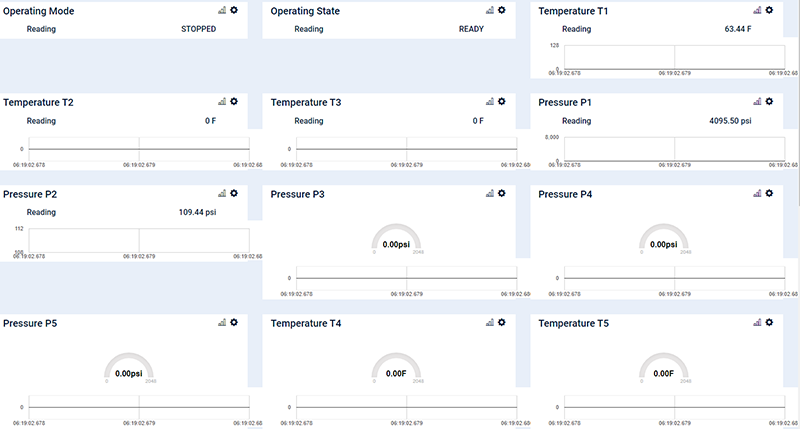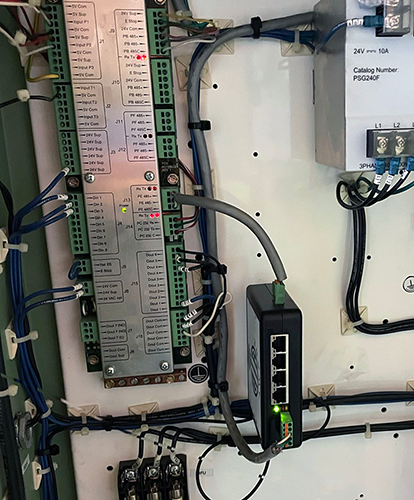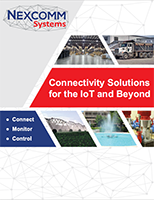Introduction
Nexcomm Systems Modbus RS-485 and Modbus TCP gateways enable the monitoring and control of drives, controllers, and PLCs from anywhere in the world at any time.
Electronic motor and pump drives, controllers and PLCs are critical to industrial processes. These systems control the important start and stop functions of motors and pumps to ensure they operate safely and prevent wear and tear on the components. They also perform run-time monitoring and control to ensure that the systems perform within tolerance and produce the desired results.
These systems still use traditional interfaces for getting data in and out of the devices. The RS-485 (now EIA / TIA-485) standard is 40 years old, but still in wide use because it works. The Modbus protocol used on 485 networks (Modbus 485) is likewise still prevalent. Modbus TCP built on Ethernet networks was the next generation after EIA / TIA-485 and is widely deployed in industrial processes.
As computer processing power has gotten cheaper and smaller over time, the monitoring and control capabilities have grown. Modern devices can perform much more complicated logic and control and monitor more parameters with greater precision and resolution than ever. The advent of the Internet of Things (IoT) has shown that the data produced by these devices can be critical to process control, quality, and predictive maintenance. The challenge has become getting the data from the device to the Cloud where it can be analyzed and acted upon.
Modern drives, controllers and PLCs generally have some capability for getting onto a network, but there are many thousands of deployed legacy devices that do not have connectivity. Nexcomm Systems Modbus RS-485 and Modbus TCP gateways with cellular connectivity connect these devices and bring them online.
The Modbus Protocol
This document is not going to get too deep into the Modbus protocol, but an overview is warranted. The protocol was originally developed in the late 1970s and had undergone several revisions over time. For the purposes of electronic motor and pump drives, it can be thought of as an electronic table. Each row in the table is called a register. The first column is the register address. Adjacent columns are the register value. The values are typically one to four bytes in length.
The number of registers depends on the drive. They can range from a few tens of registers for the more basic devices to several hundred for complicated, “full-featured” drives. Modbus commands consist of a register address, a read or write command, a value for write commands and a CRC for error detection.
While there is some standardization on register functions, most of them are device specific. Each manufacturer publishes a register map for their drives and indicates what each register function is and how many bytes each contains. For example, there could be control registers for start, stop, run time, speed, and so forth. Monitoring registers can hold values for measured sensor values, such as temperature, pressure, fuel level, etc.
Electronic motor and pump drives use the values in these registers to determine how to manage the devices they are controlling. How they use these values depends on the drive and how it is programmed. However, it is often desirable to change some of these values based on the real-time conditions in the field. For example, a municipality may want to pump down a retention pond lower than normal because a big storm is coming. This is very common in Gulf Coast areas in the United States ahead of hurricanes for flood control.
Click here for more information on the Modbus protocol.
Modbus RS-485 and Modbus TCP Drive Interface
Historically, programming the drives has been done with a computer. For basic drives, a cable is connected between the drive and the computer, and a program reads and writes values to the registers. For more complicated drives and PLCs, a complete operational program is created on the computer and then downloaded into the drive. Updates to the set points or programs typically require someone to go out to the drive, plug into it and make the required changes.
Nexcomm Modbus RS-485 and Modbus TCP Gateways
Nexcomm has developed a solution to interface to drives, controllers and PLCs remotely using Modbus 485 and Modbus TCP gateways. This consists of a cellular gateway connected to the drive and a website through the Nexcomm cloud services. A list of registers that are of interest to the application is created on the website and pushed to the gateway over the cellular network. These register values are reported to the cloud.
Once on the server, the values can be converted to human readable parameters and displayed as graphs or gauges. Alerts and alarm conditions can also be set up to email, text and call appropriate individuals based on the values.
Values to write to the registers can also be pushed down from the website. This allows the responsible party to immediately respond to an alert or alarm remotely, or take a proactive action, like pumping down a reservoir ahead of a storm.
All of this is done on a website from anywhere in the world. This allows operators to send technicians out only when absolutely necessary and plan service and maintenance in an efficient way.
The Nexus Industrial cellular gateway is housed in an IP67 rated diecast aluminum enclosure, so it can be mounted outdoors exposed to the elements. It has an RS-485 port to communicate with the drives over Modbus RS-485 and an Ethernet port to communicate with Modbus TCP or straight Ethernet. The power and RS-485 / Ethernet ports use common M8 connectors that are robust and waterproof. It natively supports Wi-Fi, Bluetooth and Thread and can optionally have Wi-Fi HaLow installed to communicate with remote sensors or devices. This is the go-to cellular gateway for outdoor and unprotected installations.
| Nexus Industrial | Specifications |
|---|---|
 |
|
The Nexus Panel cellular gateway has an RS-485 port to communicate over Modbus RS-485 and one or four Ethernet ports to communicate with Modbus TCP or straight Ethernet. It can be populated with different cards that enable different features. A four port Ethernet card connects to multiple devices through Ethernet. Cards are also available that have CT inputs, analog inputs and digital on / off inputs for sensors. It is designed to be mounted on DIN rail inside a panel, so installation is very simple.
| Nexus Panel | Specifications |
|---|---|
 |
With Ethernet Card
With RTD/CT Card
With I/O Card
|
Cloud Services for Modbus RS-485 and Modbus TCP Gateways
The Nexcomm Systems Cloud Services connect to the Modbus RS-485 and Modbus TCP gateways and offer intuitive visualization of the device’s performance based on the register values. It also generates email and SMS text message alerts in the event of fault conditions. The alerts are configurable as well as who gets them on what days and at what times. The system records service and maintenance reports entered in by field personnel and can generate reports.

The system offers a simple solution for remotely monitoring Modbus devices at a cost that is far below traditional SCADA systems. Contact us to discuss how this innovative solution can solve your needs.
What do you get for your money?
System Levels
Connectivity solutions for the IoT and beyond
Nexcomm Systems provides the complete solution for connecting devices to the cloud for monitoring and control. We offer wired and wireless sensor hubs, cellular gateways and airtime, as well as cloud services for provisioning devices, data storage, visualizations, and reports. With systems tailored to different applications, environments and price points, we are a one-stop shop for remote monitoring and control.



